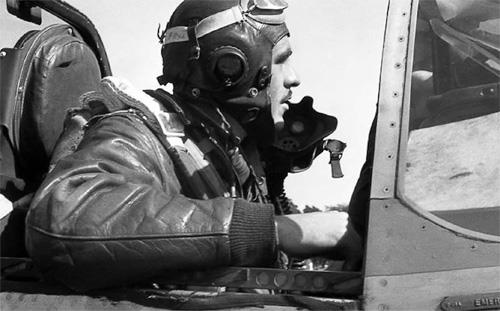
As America struggles to wind down another war that has not gone well, National Geographic is using the Memorial Day weekend to remind us of those who fought the last war that did.
Nat Geo kicks off the holiday commemoration on Thursday with two World War II documentaries: WWII in Europe: Voices From the Front at 8 p.m. ET, and Heroes of the Sky: The Real Mighty Eighth, at 9 p.m. ET.
Voices From the Front has ABC News’s Bob Woodruff interviewing some of the last surviving veterans from that war, while The Real Mighty Eighth recounts the history of the Army Air division that reclaimed the skies of Europe from the German Luftwaffe and thus played a central role in winning the war.
The cost of that victory for the Eighth was some 26,000 lives, out of 350,000 soldiers who passed through the division during its intense three-year European campaign.
Paul Tibbets, who led the Eighth’s first-ever raid on Nazi-held Europe from the division’s base in Britain, recalled that resistance was light at first, with no planes lost on the first nine missions.
Once the Luftwaffe had taken stock, Tibbets added, the “bloody reality” set in.
If the name Paul Tibbets sounds familiar from World War II history, it might be because he transferred to the Pacific theater, where he piloted the plane that dropped the first atomic bomb on Hiroshima.
Tibbets reflected on the subsequent controversy over the morality of that act by saying that for better or worse, “There is no morality in war.”
The inclusion of those Tibbets comments reflects one of the most interesting aspects of The Mighty Eighth, which is that it acknowledges some moral issues admiring documentaries often avoid.
By the time the Eighth arrived in Britain in July 1942, the British RAF had already shifted largely from daytime bombing to nights. This made it much easier for the RAF planes to avoid German defenses, but much harder to hit their targets – meaning it became much more likely the bombs would miss military installations and land on civilians.
The RAF strongly suggested the Eighth follow the same strategy, but the Eighth refused, saying the American code of aerial war was, wherever possible, to avoid civilian casualties.
By the last few months of the war, however, with the Germans in retreat yet refusing to surrender, the Eighth began heavily bombing areas – notably cities – that were not strictly military targets.
Large parts of Berlin were reduced to rubble, while Dresden, in particular, suffered extensive civilian casualties in a well-chronicled firebombing campaign.
The Mighty Eighth notes that the Germans had perpetrated that sort of destruction earlier in the war – even beyond Adolf Hitler’s broader genocidal policies.
This documentary quotes General James Doolittle, who was in charge of the Eighth for the last 16 months of the war, as strongly protesting these urban bombing campaigns, saying they violated long-standing U.S. policy because their primary purpose was not to knock out military targets but to “terrorize” the population into pressing their leaders to surrender.
Doolittle’s objection was practical as much as moral. He didn’t think destructive bombing would have the desired demoralizing effect, and brief vintage news clips here suggest he was right – that the German people continued to defiantly support Hitler.
Still, those bombing campaigns continue to spark moral and military debates 75 years later.
The Mighty Eighth also notes that the division had some serious internal problems. Most notably and costly, the fighter planes that protected the bombers had less range than the bombers themselves. So once the bombers began hitting targets in Germany itself, the fighters had to turn back to refuel, leaving the bombers on their own at great cost in planes and lives.
All that said, The Mighty Eighth is a tale of triumph. It focuses on the collective determination of the pilots and their commanders and makes a strong case that, without them, the war might have had a very different outcome.
The Eighth didn’t even exist before Pearl Harbor. Seven months later, General Ira Eaker arrived in Britain to set up a base, with no planes and seven men. Two years after that, there were 2,800 bombers.
The documentary tells a few individual stories, like that of ace pilot George Preddy, who shot down 27 German planes before he was killed by friendly fire on Christmas day 1944. It talks about Tibbets and Eaker and Lt. Col. Curtis LeMay, who instituted a strategy that cost more lives and brought more results. LeMay, by the way, flew on those missions himself.
The Eighth conducted the first raids on strategic German military production facilities. It established the air dominance that provided cover for the D-Day Invasion. It’s a legacy in which pride feels entirely justified.
One of the best things about The Mighty Eighth as a documentary is the one that also makes it feel a little choppy. It uses actual footage shot during the war, sometimes during air battles themselves.
So the visuals aren’t polished like a re-created documentary would be. They’re fragmentary and grainy. They’re also powerful. They give the two-hour documentary a very human feeling.
Even the historical footage dropped in for context, like the British waltzing in the streets on V-E Day or German crowds saluting Hitler or the French waving flags as the Allies marched back into Paris, provides a sense of what all this sacrifice bought.
The Mighty Eighth portrays the war effort as imperfect and the war itself as hell. That doesn’t lessen our national debt to those who fought it.